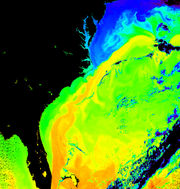 Thinking about the kind of power we might one day derive from the movement of open water has me amped. This is from an Associated Press article, “Oceans eyed as new energy source,” running Feb. 14:
Thinking about the kind of power we might one day derive from the movement of open water has me amped. This is from an Associated Press article, “Oceans eyed as new energy source,” running Feb. 14:
Just 15 miles off Florida’s coast, the world’s most powerful sustained ocean current — the mighty Gulf Stream — rushes by at nearly 8.5 billion gallons per second. And it never stops.
To scientists, it represents a tantalizing possibility: a new, plentiful and uninterrupted source of clean energy.
In the piece, Florida Atlantic University researchers strategize on how they might tap the power of all those fast-moving gigatons of H2O. (You can see the stream, above, as an orange-yellow swirl running up the black, southeast coast of the U.S.; that’s Florida sticking out at the bottom):
The current could someday be used to drive thousands of underwater turbines, produce as much energy as perhaps 10 nuclear plants and supply one-third of Florida’s electricity. A small test turbine is expected to be installed within months.
“We can produce power 24/7,” said Frederick Driscoll, director of the university’s Center of Excellence in Ocean Energy Technology. Using a $5 million research grant from the state, the university is working to develop the technology in hopes that big energy and engineering companies will eventually build huge underwater arrays of turbines.
From Oregon to Maine, Europe to Australia and beyond, researchers are looking to the sea — currents, tides and waves — for its infinite energy. So far, there are no commercial-scale projects in the U.S. delivering electricity to the grid.
Because the technology is still taking shape, it is too soon to say how much it might cost. But researchers hope to make it as cost-effective as fossil fuels. While the initial investment may be higher, the currents that drive the machinery are free.
My favorite sentence, for its sheer scientific drollness:
There are still many unknowns and risks. One fear is the “Cuisinart effect”: The spinning underwater blades could chop up fish and other creatures.
Wow. Of course, after they master that, a few decades out, they may want to turn their attention to the gold mine, so to speak: the freezing Antarctic Circumpolar Current (ACC), which rotates east to west around the continent at volumes up to five times higher than the Gulf Stream. Talk about truly untapped potential.

0 comments ↓
There are no comments yet...Kick things off by filling out the form below.
Leave a Comment